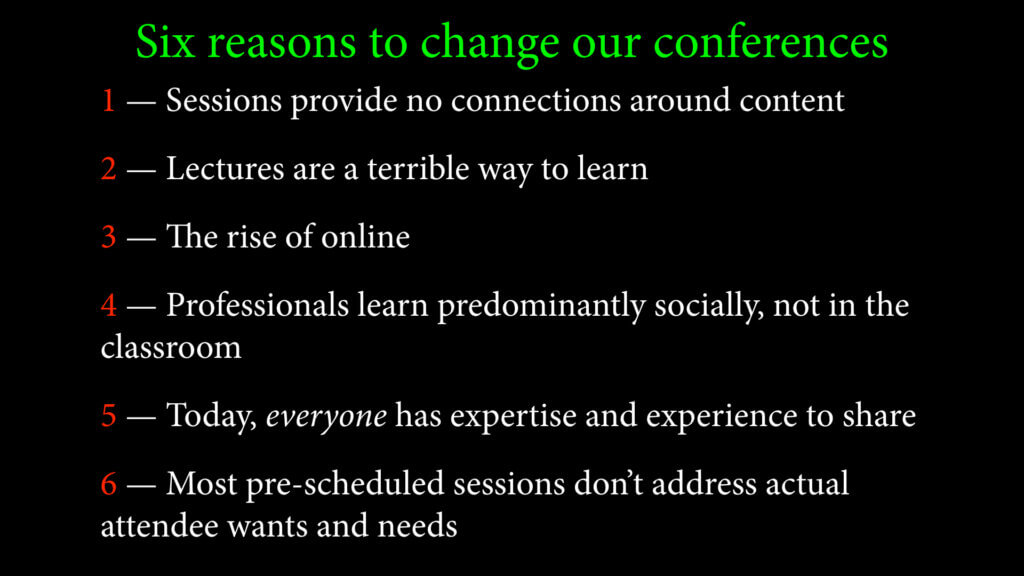Six reasons to change conferences

Although I’ve written about these issues before, this is the first time I’ve summarized them in one place. Together they make a strong business case for the participant-driven and participation-rich meetings I’ve been advocating since 1992.
Enjoy!
Sessions provide no connection around content
Today, the most important reason why people go to conferences is to usefully connect with others around relevant content. But our conference programs still focus on lectures, where a few experts broadcast their knowledge to passive listeners: the audience. During lectures, there’s no connection between audience members and no connection around lecture content.
At traditional conferences, connection is relegated to breaks, meals, and socials! That’s why you so often hear, “The best part of that conference was the conversations in the hallways.” It doesn’t have to be that way! Peer conferences provide conference sessions where participants connect around relevant, timely content.
Lectures are a terrible way to learn
We’ve known for over a hundred years that lectures are a terrible way to learn something. Lectures are a seductive meeting format because they are very efficient ways of sharing information. Unfortunately, lectures are perhaps the least effective way of learning anything.
Why? Over time, we rapidly forget almost everything someone tells us. But when we engage with content, we remember more of it, remember it more accurately, and remember it longer. Every measure of learning increases drastically when attendees actively participate while learning in sessions.
The rise of online
Most broadcast content is now readily available online. An internet connection provides expert content anywhere, just in time when it’s needed. You don’t need to go to conferences for broadcast content (which you’ll probably have forgotten by the time you need it) anymore!
Professionals learn predominantly socially, not in the classroom
Until about twenty years ago, professionals learned most of what they needed to know to do their jobs in the classroom. Today we know that only about 10% of what we need to know to do our jobs involves formal classroom teaching. The other 90% is informal, provided by a combination of self-directed learning and social, active, experiential learning with our peers on the job or (what an opportunity!) at conferences with our peers.
Though ~90% of the learning modalities adult workers need these days are informal social learning from our peers, we persist in making the bulk of “education” at meetings formal presentations by a few experts! Instead, we need to concentrate on and provide maximum opportunities for the just-in-time peer learning our attendees need and want.
Today, everyone has expertise and experience to share
Everyone who has worked in a profession for a while is an expert resource for some of her or his peers. Instead of limiting content to broadcast by a few “experts”, peer conferences provide process and support to uncover and tap the thousands of years of expertise and experience in the room. Remember how David Weinberger puts it: “The smartest person in the room is the room.” We need conference process that uncovers and taps everyone’s experience and expertise while people are together at the conference!
Most pre-scheduled sessions don’t address actual attendee wants and needs
Because we’ll forget learning that isn’t currently needed and reinforced, conferences need to provide just-in-time learning. And you can’t predict most of the just-in-time learning by asking a program committee, or attendees for that matter, in advance. My research has found that 50 – 90% of all pre-scheduled conference sessions are not what attendees actually want and need! In contrast, just about all peer conference sessions, chosen and run by participants during the event, are rated highly because they provide the just-in-time learning and connection that participants want from the event.
Conclusion
My books explore these six reasons to change conferences in detail. To get the full story, buy ’em!

 Sorry folks, but traditional conferences are obsolete.
Sorry folks, but traditional conferences are obsolete.